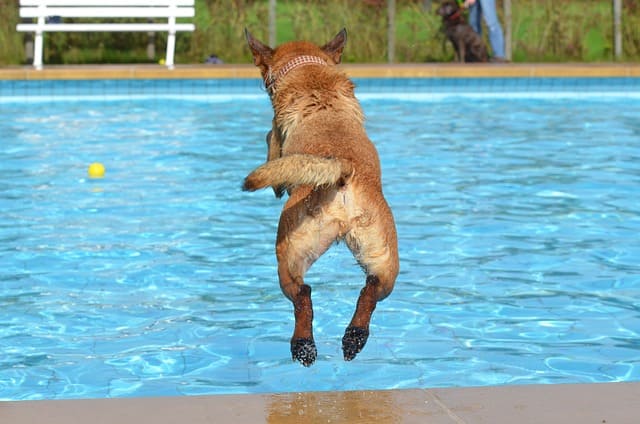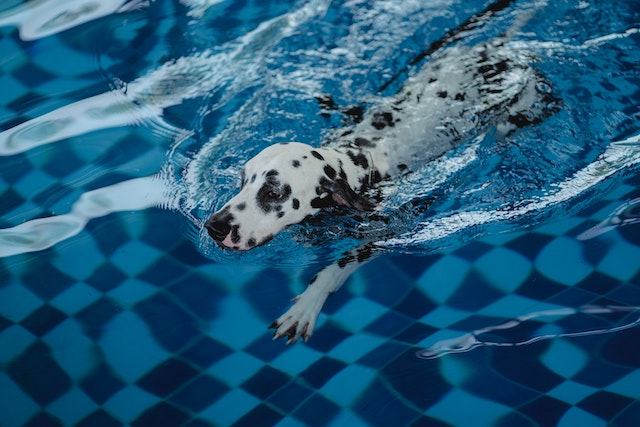

Canine Hydrotherapy: What Is It And What Are The Benefits?
Alternative treatment methods like hydrotherapy are growing more and more popular with pet owners as they look for new ways to keep pets happy and healthy throughout their lives. Join us for a deep dive (get it?) into this exciting field

Writer Elinor Saloniki
10 min read

Whether it’s an early morning dip in the sea or a relaxing soak in the bubbling hot waters of a jacuzzi, humans have long appreciated the therapeutic benefits of water. Many owners can testify that their pets enjoy a doggy paddle just as much as they do. It’s only in more recent years, however, that the benefits of water therapy for dogs in controlled and monitored settings has been recognized – and seriously studied.
What is hydrotherapy?
The use of hydrotherapy to soothe the body and mind stretches back over 2,000 years to the days of Ancient Greece. Bathers of old recognized that swimming in open water, pools, mineral baths, and saunas could provide comfort for stressed joints, as well as help to heal injuries and relax the mind.
What is hydrotherapy for dogs?
If your dog loves muddy puddles or chasing balls into the surf without stopping to ‘paws’, you may start to believe they’ve discovered canine hydrotherapy on their own. Therapeutic hydrotherapy, however, is much more than water-based horseplay. Speaking of horses, it was the horse- and greyhound-racing industries that first discovered its benefits for animals. Letting horses and dogs walk in water helped both recover from injuries while keeping them in tip-top condition for their next outing on the racetrack.
With the invention of underwater treadmills, the use of hydrotherapy soon spread to the general dog population. Yes, even if your pup is an especially chonky boi. Hydrotherapy’s mix of buoyancy, viscosity, resistance, and hydrostatic pressure provides a beneficial form of physical therapy. Joints and muscles are protected, while dogs reap the benefits of recuperative exercise, including pain relief, anti-inflammatory effects, and improved cardiovascular health. In other words, it can help with recuperation whether the cause is injury, illness or surgery. Even better, the fact that it’s so low impact means that no undue stress is placed on the dog’s joints and muscles.
In today’s veterinary medicine, hydrotherapy may be a complementary treatment, coupled with other more conventional forms of medicine, or as a supportive treatment for chronic conditions. Either way, hydrotherapy is supervised by specialized vets who have undergone specific hydrotherapy or physical therapy training.
How do dogs benefit from hydrotherapy?
Canine water therapy brings a whole raft of benefits for dogs, whether it’s relieving the pain of arthritis or helping broken bones to heal. It’s especially beneficial for dogs who suffer from torn cruciate ligaments, hip dysplasia, discomfort related to limb amputation, degenerative joint diseases, and those who have recently undergone any form of major surgery. A soak in a water pool can also alleviate neurological problems and help with chronic medical conditions such as Cushing’s disease.
Recreational water therapy for dogs is also an excellent way to keep active dogs in shape. Physical conditioning exercises in water increase stamina and endurance, strengthen muscles, and help minimize the chances of muscle strain and joint injuries. Exercising in water can even deliver better results than when dogs undertake similar exercises out of the water. For example, trotting on an underwater treadmill for two miles provides the equivalent benefit to running four to five miles on dry land. Now that’s some serious bang for your buck.
Resistance, buoyancy, viscosity, and pressure: water’s attributes are key to hydrotherapy’s benefits
- Buoyancy – the principal advantage of water workouts. Once the dog is submerged in water, their body loses ⅔ of its mass, which allows to significantly reduce gravity’s effects. The dog being able to float in water places them in a horizontal position, which better supports their body and alleviates pain by exerting extra pressure on the spine and joints, or wearing down connective tissues in the tendons and ligaments.
- Water resistance – water molecules are drawn to one another and create resistance for the body’s movement in water. The strength of the resistance depends on the speed of movement, the body’s surface area, and how deep it’s submerged. Using this attribute in a controlled fashion helps improve physical fitness, movement, and stability, as well as builds muscle mass, since muscles need to strain harder when moving a body in water.
- Hydrostatic pressure – water pressure on the limbs and the part of the body that’s submerged underwater helps prevent and alleviate swelling by removing accumulating debris and fluids away from the area of the injury. Likewise, the pressure around the chest area makes it harder to breathe, and consequently improves cardiovascular ability since the heart and lungs need to work that much harder.
- Viscosity – water’s viscosity helps stabilize joints, maintain equilibrium, and improve range of motion in water, which is especially helpful for dogs with spinal injuries.
- Water temperature – warm water helps relax muscle spasms and provides immediate pain relief.
What types of water therapy are available for dogs?
There are three main types of water therapy for dogs. All use water at a comfortable and therapeutic temperature of between 86 and 89 degrees Fahrenheit. How they differ is in terms of the equipment and processes used. Your vet will advise you on which form of canine water therapy is best for your pet’s unique needs.
Pool therapy

Swimming sessions in a hydrotherapy pool are ideal if your dog suffers from arthritis or has a degenerative joint disease, such as hip or elbow dysplasia. Canine water therapy in a pool also delivers a good cardiovascular workout and burns calories. It’s a great choice if your dog has a tendency to overindulge on treats! Dog therapy pools vary widely in size and depth, so it’s a good idea for dogs to wear a flotation device or at least a harness when swimming in one. A therapist should always be present to monitor the dog’s movements and progress. The downside of pool therapy, however, is that swimming is really the only form of exercise that can be performed. Other types of water therapy allow for a wider variety of activities.
Underwater treadmills
If you like hitting the gym for a cardio exercise on the treadmill, why not let your dog enjoy similar exercise while experiencing the benefits of hydrotherapy? Underwater treadmills are perhaps the most common form of hydrotherapy for dogs. A treadmill is enclosed in a glass or plastic chamber. The dog walks in, the door is sealed shut, and a controlled flow of water enters the chamber. This water stops just above the dog’s hip joints. As the treadmill starts to move slowly, the dog starts walking. This walking motion strengthens joint muscles while removing the high-impact stress of walking on hard ground. Pressure on the joints is removed and walking is more comfortable for dogs with painful arthritis or those who are recovering from surgery. The therapist can tailor any session to the dog’s exact needs by controlling the speed, incline, water level, and duration of the treadmill session. This means different areas can be targeted to build and increase muscle mass while re-educating the dog’s walking gait and proprioception (sense of its own motion). Underwater treadmills are a particularly kind and effective way of managing the exercise needs of geriatric dogs.
Whirlpool therapy
The biggest benefit of whirlpool therapy (or jacuzzis for canines) is pain relief. It’s especially effective when dogs are recovering from major surgical procedures. The dog is supported by a harness and slowly lowered into the water where warm jet streams gently massage injured muscles and wound sites.
Water therapy at home: pros and cons
Hydrotherapy for dogs can be expensive but, if recommended by a vet, is potentially covered as an extra or add-on by some pet insurers, while others – like Animalia – offer it as part of their base package. It is possible, however, to do some form of hydrotherapy for dogs at home or when out and about. Recreational swimming and paddling are great fun and exercise for dogs who love the water. For some smaller breeds, you can even make use of a kiddie pool in your backyard or driveway!

Just remember that not all dogs are natural swimmers. Rescue organizations are often called upon to haul drowning dogs out of water when their sense of adventure overcomes their survival instinct! If you’re letting your dog swim in large bodies of water such as the ocean or a lake, make sure they have a properly fitted flotation jacket. If your pet has specific needs, letting them swim or play in water unsupervised may make injuries or illnesses worse. Dedicated canine water therapy should always take place in safe environments where the water level and temperature are properly controlled.
Can all dogs benefit from hydrotherapy?
Any form of canine hydrotherapy should be avoided if your pet has an underlying disease or an open wound. Also, it’s not a good idea to let dogs suffering from ear problems go into water. Water may get inside their ears, causing discomfort and aggravating the condition. Dogs who are nervous about water or who don’t enjoy being immersed should never be forced to swim. The psychological damage of such an experience can have lifelong effects. Whether you’re encouraging your dog into open water or starting a hydrotherapy session, if they show any signs of anxiety, the session should be stopped immediately. The stress of the experience can raise your dog’s blood pressure and heart rate, potentially increasing the risk of a cardiovascular emergency.
So who can benefit from hydrotherapy?
- Dogs suffering from various orthopedic issues – hydrotherapy treatment can be part of a conservative treatment plan or part of the rehabilitation process, before or after surgery. This can help with problems such as hip or elbow dysplasia, cruciate ligament tears, patellar luxation, joint fractures, various types of arthritis, and more.
- Dogs suffering from neurological issues – herniated discs, spinal injuries due to trauma or other causes, degenerative nerve diseases, and more.
- Dogs recovering from various surgeries.
- Dogs suffering from soft tissue injuries surrounding the bones and joints.
- Dogs suffering from age-related health conditions – weakness in the hind legs, cardiovascular endurance or reduced muscle mass, rickets, obesity, and more.
- Dogs suffering from chronic disabilities – as a result of trauma, accidents, or congenital conditions.
Hydrotherapy is also beneficial for preventative medicine
Approximately 80% of dogs weighing 90 pounds or more are likely to suffer from joint and back problems by the time they reach the age of 8. In the case of large dogs showing initial signs of joint problems, it’s very important to start a treatment plan that includes preservation and prevention to reduce the risk of future injuries and surgeries. Since swimming, buoyancy, and water currents have been found to strengthen the skeletal and joint system, hydrotherapy can definitely help with preventing muscle atrophy and arthritis.
Animalia understands the importance of not just treating injuries, accidents, and diseases but also providing rehabilitation after recuperation. That’s precisely why hydrotherapy is included in the coverage our dog insurance offers (terms apply). Get your quote today.





We offer the most
comprehensive coverage
out there
car with a spare tire for life’s bumps.
Having Animalia is like a pimped-out
Rolls Royce with a swimming pool
in the trunk.



Get your pet insurance quote
Pet type
- Dog
- Cat
What is your pet's name?
Zip code






